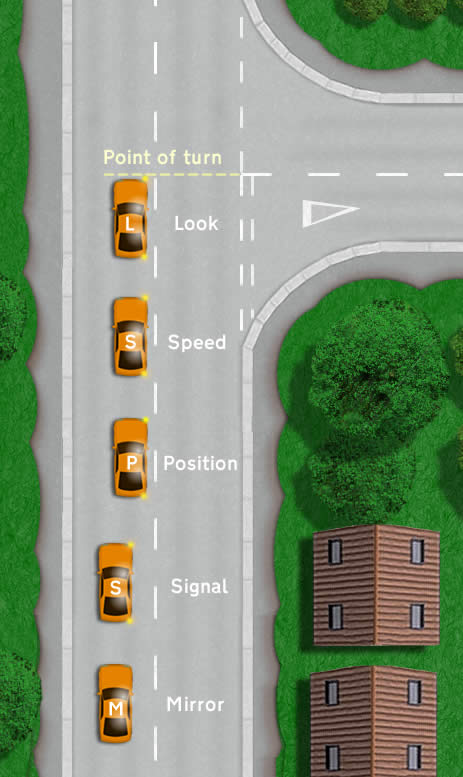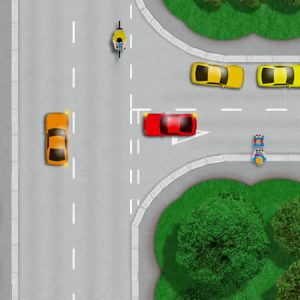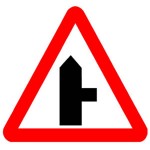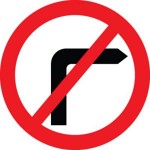Turning right can be challenging for a learner driver due to hesitation and not being confident or fully understanding when they should wait or go.
The driving test will of course involve many right turns on quiet residential or country roads, up to high speed national speed limit roads. Understanding the correct routine, rules for making right turns, the correct position and when to give way to oncoming traffic is essential.
This tutorial explains this along with any right turn road signs that may be encountered.
Locating a right turn
As with left turns, locating the right turn at the earliest opportunity will give you plenty of to prepare and take appropriate observations. Check for right turn road signs, but some turns can be difficult to see.
To help, look for gaps in houses, bushes/trees or parked cars that may indicate the right turn is ahead.
Right turn rules for the driving test
There will be many right turns that you will be taking during the driving test. Each of these, you will be expected to use the MSPSL (Mirror, Signal, Position, Speed and Look) routine. Starting at the bottom of the diagram, we shall follow the correct rules for making a right turn during a driving test.

-
Mirror
Upon locating where the right turn ahead is, look into the interior mirror, followed by the right wing mirror.
-
Signal
Signal to the right immediately after the mirrors.
-
Position
Position your car just to the left of the centre of the road. If there is a centre road marking, ensure you do not position your car on or over the line.
-
Speed
Speed is dependent on whether you need to stop and give way to oncoming traffic and how clear (open or closed/blind) the right turn you wish to take is. If you do not need to give way and the right turn is open, usually taking the turn in 2nd gear at around 10-15 mph is sufficient. If the right turn is closed, and difficult to navigate, 1st gear at around 5 mph may be appropriate.
-
Look
You must look to determine if the right turn is open or closed and also to ensure the junction is free from cyclists and pedestrians before making the turn. If there are pedestrians or cyclists crossing, wait at the point of turn position before turning.
FOR A MORE IN DEPTH LOOK INTO THE THIS ROUTINE, SEE:
Turning right point of turn
Line the very front of your car up with the centre line of the road you intend on taking. The point of turn will eliminate making the turn too soon. Taking the right turn too soon will result in cutting the corner and driving on the wrong side of the new road. This will fail a driving test and is dangerous for oncoming vehicles coming out of the right turn. The point of turn will also eliminate the potential of taking the turn too late and possibly hitting the kerb or even mounting the pavement, both of which is likely to fail the driving test in this situation.
Give way to oncoming traffic
If you need to give way to oncoming traffic, ensure you stop at the point of turn. It can be difficult for a learner driver to know when to make the turn safely when confronted with oncoming traffic. As a guide, think of yourself as a pedestrian standing in the road exactly where you are sitting at the point of turn. When, as a pedestrian you feel it is safe to walk to the other side of the road to the right, would be a good indication that it is safe to make the turn in your car. This technique is only applicable to residential and city roads that have a speed limit of 30 mph.
Right turn hazards
Turning right may of course involve giving way to oncoming traffic, but in many respects it can be easier than turning left. Your view of the road you intend to take is much clearer when making right turns and therefore spotting hazards is easier.

Hazards to be aware of are pedestrians crossing the road at the junction lines and cyclists that can often be difficult to see. Also look out for narrow roads that may have cars parked close to the junction line as you may need to give way soon after you have made the right turn.
Making a right turn tips
- Try to locate the turn as soon as possible by use of signs, road markings or gaps in trees and houses.
- Use the MSPSL routine on the driving test.
- Stop at the point if turn to eliminate driving on the wrong side of the road or hitting the kerb.
- Check for hazards such as pedestrians crossing the road, cyclists or parked cars before making the turn.
Right turn signs
Whilst driving, especially during a driving test, locating a right turn in plenty of time will provide you with more time to prepare. The examiner may possibly ask you to take the next available road on the right. Be careful as the next junction on the right may be no entry and will have a sign similar to the no right turn sign below. Obviously making a right turn in this situation is illegal and would fail any driving test. Examiner aren’t trying to trick you into making a mistake, they simply want to ensure you are taking notice of all road signs.



Hi thank you for explaining the right turns as I have failed my driving test 3 times due to right turn at the lights 2 times and one time at a junction when turning right in sha Allah next time I do not make any mistakes and pass if Allah wills thanks again for explaining it helped a lot
You’re welcome. Hope it helps you to pass the driving test next time – and good luck!
In this photo above, who should give way while turning, the red car or the orange car?
It’s the cyclists lane that both cars need to cross, so they both need to give way to the cyclist. Once the cyclist has passed, the red car then must give way to the orange car.
Thank you 😊
Hi
In respect of right turn, I have a query. In your tutorial, you have mentioned the point of turn as follows. the bonnet of the car is lined up with the centre of the road on the right side road. My instructor says for point of turn even if we line up the right side door mirror of the car with the centre of the road on the right side of the mirror it will be correct.
Please advise on this.
Regards
Hello Priya,
It’s not an exact science, it’s a reference point to give learner drivers something to gauge with. Making the reference point further forward at the door mirror means you might have to turn a bit quicker, particularly into a narrow road so as not to overshoot the junction, whereas you don’t have that problem by making the reference point at the front of the bonnet.
Thank you very much!!!
Hi
My turning on left and right was getting better from the minor road to major road but from major road to minor road, it is not improving. Every time I end up either turning more or less. I am not getting the proper judgment. Today from Major road to minor road right turn I have turned less and was about to hit the pavement and in one more right turn same from Major road to minor road I have turned more. Could you please advise me do I have to keep the rod width in mind. Can you please help me with this. My instructor is very strict and she shouts and then other simple things also I do wrong. Please advise.
Regards
Priya
Hi Priya,
You need to do what I explained in the ‘turning left‘ page. The only way around this is to keep practicing, use reference points to help you and be persistent until you get the hang of it. There’s no easy fix I’m afraid. The only other thing I would recommend is to change instructor. An instructor that shouts is an instructor that is not training you properly.
Hi
I have a specific query on the right turn. I have noticed in your right turn tutorial as we all on road we stop or slow down at 90-degree angle at right turn but in some right turn, we turn the steering wheel little bit on the right side (front wheel will be slightly turned on the right). Could you please advise why it is so?
Thanks
Priya.
Hi Priya,
For positioning when turning right at a junction, you should keep the wheels straight when stopped at the point of turn. That way, you’ll know the car is straight and parallel. If you turn the wheel, you’ll risk the front of your car going over the centre line as you stop. With the point of turn being at the front of the car, there’s no need to ‘prepare’ for the turn. There’s plenty of time to make the turn provided you keep the car slow and turn the steering wheel reasonably quickly.
Hi
When you are turning right from a main road into a narrow road with obstructions like parked cars on the left of the narrow road your turning into, but no oncoming traffic on the main road. Would you still stop at the point if turn so you can gauge what the side road is like etc the parked cars, oncoming traffic approaching from the other end of the side road etc
Hello Mark,
The point of turn is simply a reference point as when turning right, stopping at the point of turn offers the driver a good view down the road they intend to enter and also a good turning point so that they don’t cut across junction lines. So you don’t have to stop at the point of turn, but be sure that you can always see that the road you intend on entering is clear from oncoming traffic and that you do not cut across any junction lines when making the turn. Always aim when making the turn to enter the new road into the left lane and avoid cutting across the right lane when turning – though very badly parked cars (right up to the junction line) may on occasions prevent this.
Hi, please can someone advise me. When at traffic lights when wanting to turn right and there is no right arrow, do you have to move forward in middle of road and give way to oncoming traffic, when light turns green or do you stay sitting behind white line?
Hello Rae,
The green light is for you to go so yes, you can move forward into the middle of the road ready to go when clear to do so. Before doing so, also ensure your exit road is clear before moving forward else you’ll block the junction when the lights change.
In reply to Elhassouni.
the red car. as the orange is turning off the main carriageway
I keep getting bleeped if a car is behind me when I turn right into my drive I can’t understand why.I love on a country road with fields on one side i do mirror signal manuver but I’ve got a right turn just before mine and it’s on a bend so I pass that before I indicate i I can’t think what else to do if I indicate any sooner it will look like I’m turning into the other road
Hi Sheila,
Generally speaking, you’re on the right lines by not indicating before the other right turn to avoid confusing other drivers. However, in your situation and especially as you live on a country road, I would indicate before the other right turn. The reason being is that country roads are actually quite dangerous – the most accidents happen on country roads. I do agree that by indicating too early that it might cause confusion for following drivers who might think you’re turning into the road before your drive, but it’s more important that other drivers are given adequate time to slow down and prepare for your turn.
I failed at the end of a test. I was turning right entering to the test center from main road .
There was oncoming learner car which is going straight on the main road. He waited there so I thought he may not indicate and wanted to turn into test center too.
So I made my turn right and the examiner shout at me that you must stopped for oncoming learner car as he is going straight.
That reason I failed as the examiner marked it as a serious fault (judgement crossing)
Is it really serious fault?
Hi OwnKing,
From how I read it, you’re waiting to turn right from the main road into the test centre and a approaching learner driver has stopped in front of your vehicle, just before the right turn into the test centre?
I would say that unless the driver of the approaching car has given you explicit instruction that you can turn in front of them, that could be a hand gesture, or flashing their lights (unlikely being as it was a learner), then the examiner is correct and you should have waited. This is even more apparent being as it was a learner driver, who can be unpredictable. It’s unfortunate that you failed right at the last moment (if that’s the case). Better luck next time.
If I’m turning right and another car coming from the opposite direction is turning right also,who goes first?
Hello Cookie,
Assuming that the junction is not light controlled, then nobody will have priority and either driver can proceed at will. Priority will simply be down to the driver that goes first.
I was asked to turn right but a car was parked
On the corner, so I had to use the left lane to turn right so he failed me but what should I have done at that point. Tell the instructor there’s a car parked on the turning lane, then go straight and turn around, come back and turn left into the street?
Hi Shezni,
That’s an unfortunate situation. Was there enough room after the parked car to get back into your lane? Were you too far away from the badly parked car and could have been more in your lane?
If the answer to those is no, then I can’t see what else you could have done.
Did the examiner not explain what you should have done?